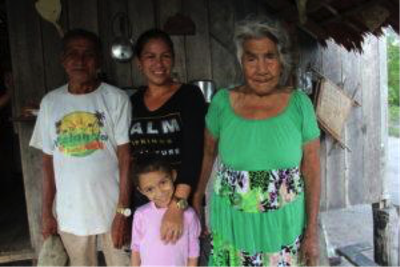Ceremony celebrates and revives Apurinã indigenous culture in the Amazon
The Apurinã, an indigenous group that live along the Purus River in southern Amazonas, have identified the need to value and strengthen their own culture through projects implemented by indigenous associations. Leaders from Pauini municipality saw the direct provision of small grants to indigenous associations – a PCAB initiative implemented by the Brazilian Education Institute (IEB) – as an opportunity for Seruini River indigenous villages to strengthen their ties with each other, as well as practice and share their traditional knowledge.
In late June, they hosted the annual Kyynyry Festival (also known as xingané). Several members of the Marienê Indigenous Land villages attended the event, including Dona Elza, a 106-year-old elder who now lives in the Peneri/Tacaquiri Indigenous Land and had not visited any village on the Seruini River for over 50 years. She is the oldest Apurinã still living in the region.
“The ceremony is led by local warriors – all of whom are men. They have the responsibility of providing food for the guests, including game meat, fish and fruit. The women, in turn, are in charge of preparing and cooking the food," explains Alex Sena, Regional Coordinator of the Federation of Indigenous Organizations and Communities of the Médio Purus (FOCIMP). As the Apurinã have been in contact with the outside world since the mid-18th century, their culture was greatly affected by the Amazon rubber boom.
According to Marina Villarinho, adviser to the IEB Indigenous Peoples Program, “during the rubber economic cycle, Apurinã groups were coerced into not using their own language and not passing on their native customs. One of their survival strategies was to omit culture itself at the time. However, several cultural traits are still present in their practices and knowledge, and regain life in ceremonies such as the xingané”. Under the umbrella of the PCAB Small Projects Program, the Apurinã and Jamamadi Indigenous Peoples Organization (OPIAJ) in Pauini has carried out a survey on their linguistic and cultural health. Two teams of youngsters were trained during a workshop, after which they visited local villages to find out how many people still spoke their language, and list the native techniques and technologies that could still be found in each indigenous land. The results of their diagnostic study are still being systematized.
The preparation and hosting of the xingané enables the practice and sharing of traditional knowledge about their land, including hunting and fishing areas; growing traditional plants; body painting techniques; collecting vines to make panniers (the baskets where women store meat, which is first salted, grilled and smoked to last longer); and making straw skirts for their dance performances.
It is also necessary to learn the color composition of headdresses, the ripening time for different fruits, and the full-moon cycle to ensure their ceremonies can take place under natural light. In addition, they need to master the dance steps, know where the singers live, what they sing about, as well as learn their language – which has been restricted to very few speakers. The xingané is essentially a management tool to ensure the survival of Apurinã culture and knowledge.
This year’s xingané, in particular, focused on bringing relatives closer together, and allowing them to revisit memories of their past, and cherish their interactions and sense of belonging. This is why the story of Dona Elza, the oldest kyru in the municipality of Pauini, stands out.
As she reunited with the river, Dona Elza stopped at several villages. Wherever she went, she was welcomed with warm hugs, and offered her "blessings" to many nephews, grandchildren and children raised by her. She also shared memories of the places and people she met along the river. Always accompanied by her granddaughter Antonia Julião and her five-year-old great-granddaughter, Agata, she sang in her soft but firm voice, and led the dance in slow steps.
In the words of Teixeira, a chief at the Kamarapa village, “the xingané is also meant for that, so we can learn.” Teixeira spoke of the emotion he felt during the last song, which closed the festival, as people said their farewells. He thought of his late father, and could not hold back his tears while dancing.
Dário Lopes Apurinã (Kakoyori) is a chief at the Bom Jesus village. In his role as host, he was one of the singers at the xingané. After all guests had arrived, Dário gathered them together to talk about how important the festival is to the Apurinã: it is a time for all to remember the past in order to strengthen their knowledge. This was also an opportunity to thank everyone for their collaboration and to acknowledge that maintaining their culture alive is the responsibility of all Apurinãs.


